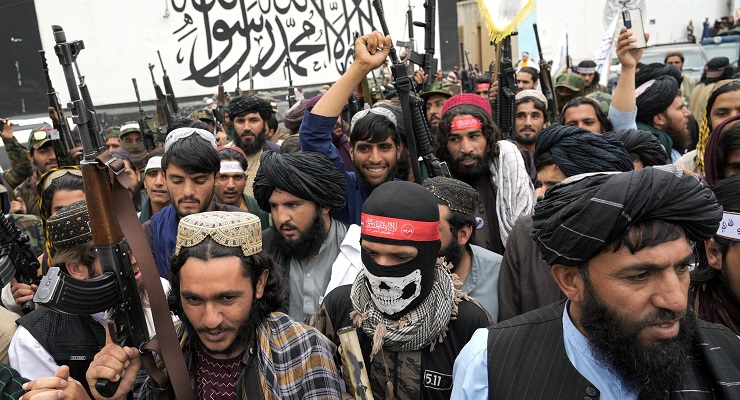
Eight women squeezed into a stuffy, windowless hotel room in Afghanistan’s southeastern borderlands, their eyes filled with both fear and determination as they detailed their escape plan.
“We just can’t get caught by the Taliban. They are preventing women from going to Pakistan,” said Farahnaz Azizi, 24, motioning for everyone to keep quiet. All eight managed to cross the border successfully in October 2021, two months after the Taliban had stormed into Kabul, once again establishing their long-feared Islamic Emirate.
Hundreds of thousands of Afghans have since left their homeland, including more than 122,000 people who were airlifted out by the United States and its allies, many of them during the chaotic evacuation from Kabul’s airport immediately following the group’s takeover on August 15, 2021. Back then, Taliban fighters flooded into the capital, roaming the streets, visiting the zoo, and taking paddle boats out on Kabul’s Qargha Lake. They’ve been busier lately.
One year on, some things in Afghanistan have improved. Corruption, a bane of the former Afghan republic, is apparently on the wane. Large-scale fighting has largely stopped (though there is plenty of sporadic violence in certain regions), and people in rural areas are rebuilding. At the same time, almost every Afghan is now, according to the United Nations, living below the poverty line. The Taliban have killed former government employees and security officials, and women have — again — been stripped of most of the rights they’d won back after the Taliban’s previous regime in the 1990s. The media, both local and international, has been eviscerated.
But even an extremist leviathan can be a relief after an existence that was all too often nasty and brutish — and nearly cut short. Ala’a Mohammad, a 30-year-old father of nine children who survived a mortar attack weeks before the Taliban took over his native Wardak province, said his family had been hiding in an underground cowshed when fighting broke out. Over the past 20 years of fighting between the United States and its coalition allies and the Taliban, almost 50,000 Afghan civilians were killed in the war.
“Toward the end [of the republic], there was daily fighting,” Mohammad said. “We were tired. We don’t support the Taliban, but we’re glad things have calmed down on the frontlines.”
In Helmand province’s Sangin district, previously a battleground between the Taliban and mostly British forces, construction workers are starting from scratch in a town that was razed to the ground. “The war is over; the foreigners left. My house was destroyed, but this time, I can rebuild without fearing more fighting,” said Mohammed Wali, 50. It’s not just Wali’s house that’s getting a touch-up. Throughout the country, workers have been deployed to fix roads, which are in terrible shape despite an estimated US$3 billion in US spending over the years. What the Taliban’s improvised explosive devises didn’t do by blowing up the pavement, the scorching sun and heavy trucks have by melting and wrecking the asphalt.
If the roads are torn up, Afghan lives are shattered. Desperation is widespread. Ethnic minorities and others like the LGBTIQA+ community no longer feel safe. The once-vibrant capital of Kabul — though still busy — seems to have lost its spirit. Beggars crowd the roads, and men still line up outside banks, desperate to get their hands on cash as billions of dollars in Afghan funds remain frozen in US accounts. The Taliban disagree with one another. Women disagree with the Taliban’s new restrictions.
The Ministry for the Propagation of Virtue and the Prevention of Vice, which replaced the old Ministry of Women’s Affairs, has hung big posters in Kabul suggesting that women who go outside should be fully covered, including their faces.
Hosey, 24, isn’t doing so because she hasn’t been out much this past year, an attempt to avoid the new rulers at all cost. Previously a student at the American University of Afghanistan, most of her friends left the country. She stayed behind.
“They rushed to the airport when the Taliban arrived. I was too scared, but today I regret not having gone,” she said, preferring to share her first name only. “My friends are safe now, and I am happy for them, but there’s nothing left for me here.”
During their stampede back into power, the Taliban hinted that they’d take a different line this time around than the first time they ran the place from 1996 to 2001, when they imposed an extremely harsh version of their interpretation of Islam. It didn’t work out that way, said Fereshta Abbasi, a researcher at Human Rights Watch. “Restrictions put in place have made it difficult for women to have a normal life, and many feel hopeless. Afghanistan is experiencing the worst humanitarian and human rights crisis.”
Even in remote places where the Taliban haven’t gone, their remit sure has. Ten-year-old Roya lives in Chil Dokhtaran, a remote village deep in the mountains of Afghanistan’s Bamiyan province in the country’s central highlands. She’s an ethnic Hazara, a minority that has long been harassed by the Taliban and massacred during their previous regime in the 1990s. “The closest government school is a two-hour walk from here, and it’s now closed to girls after grade six,” Roya explained. She had high ambitions: first high school, then university, maybe medical school. Her father has been pushing her to dream big. But “dreaming isn’t possible anymore,” she said.
Few of the new rulers have been to university themselves. At Kabul’s Mashal University, they are trying to catch up.
“We have more than 100 Taliban studying here. Most of them aren’t from Kabul but moved here from Pakistan after August,” said Najibullah Bahadar, the university’s academic vice chancellor. “They work in ministries and the intelligence service; we even teach deputy ministers and Mullah [Abdul Ghani] Baradar’s chief of staff. They need to be educated as soon as possible,” he said, adding that “they studied in brainwash centres before”.
Bahadar has both the Taliban and the old Afghan national flag behind him in his office. He’s keeping both; several Taliban have admitted they love Afghanistan’s tricolors too.
One of his Talib students is Salem Maslum, 30, a commander in the special forces who is studying political science. He speaks softly but is visibly ambitious. “I always wanted to go to university but didn’t have the chance during the war. I’m busy with my job now, but I never miss my classes in the evenings,” he said. He’d been driving all day, he explained, back from the remote Nuristan province in eastern Afghanistan. “It’s an opportunity I take seriously,” he added.
There are still a few women studying at Mashal University too; they all started before the establishment of the Islamic Emirate. There’s not a big job placement push on campus, though. “Those who have the chance to escape will do so, of course. There are not enough jobs for them here — and no future,” Bahadar said.
And while those who left are deemed the lucky ones, life abroad isn’t all that glamorous either. Most Afghans feel deeply connected to their homeland; like almost all refugees always and everywhere, they didn’t choose their lot.
In an Abu Dhabi camp, thousands of people who escaped Kabul last year are still “smouldering in the sun” and several have died, said Zaki Rasoli, 28, a well-known Afghan mixed martial artist. Rasoli no longer felt safe living under the Taliban and pursuing his career at the same time. Last October, just as Azizi and the other women slipped across the border to Pakistan, he was evacuated by Save Our Allies, a U.S. nonprofit, to a camp in Abu Dhabi, which he hasn’t been allowed to leave since.
“We’re all stuck in limbo. Some people have become suicidal. I have panic attacks, mental breakdowns, and a lot of anxiety, something I didn’t experience before,” he said.
“You know, life was good in Kabul before. Fulfilling. Now, there’s no hope left.”









Afghanistan would like their 10 billion in foreign reserves returned, guess which corrupt nation says no.
War reparations would be nice too.
“The foreigners left”. Is all. Now please let them have their money back, and give them any help for which they ask. Then maybe one day we can eradicate polio.
Give back their own money, only fair, but maybe give aid money for girls education only.
Food and medical care for all is far more important than education at this time.
The people threw the west out. Fair enough, we had no business being there in the first place. They wanted the Taliban and now they have to live with or not, but it’s up to them. Let aid come from those who supported them, primarily Pakistan.
Humanitarian aid is deserved by all and politics has no bearing on suffering. This is a far greater humanitarian crisis, and one caused by the West, than Ukraine. Or is aid only deserved by white Christian European countries?
The Northern Alliance was every bit as brutal and misogynistic as the Taliban, but more corrupt. Maybe ‘the people’ didn’t want another generation of their kids slaughtered in another 20 years of war against a foreign invader – something you wouldn’t understand as an affluent, arrogant Westerner who treats brown people as just subhuman collateral damage in the West’s imperial weapons-testing adventures.
Maybe Carter and the US shouldn’t have funded Islamic terrorists to destabilise Afghanistan when it was gradually transitioning to a secular, progressive society back in 1979. But hey, easier to just blame the victim, isn’t it, Bref.
Stefanie, why don’t you check with your Crikey colleague Guy Rundle? I am sure that he will (try) to reassure you that all this negative news about how the Islamic Taliban is running things in Afghanistan is simply a ‘beat-up’ and that the Afghani people are living an idyllic life.